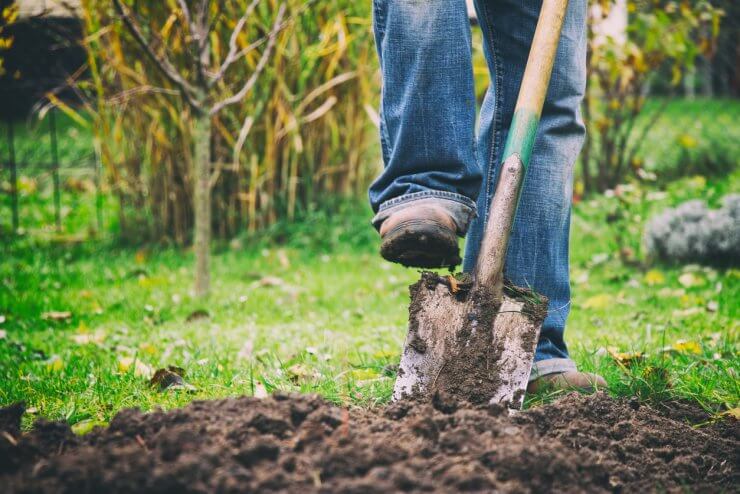
How’s the back? Has it stopped aching yet? Charles Dudley Warner said: “What one needs in gardening is a cast-iron back with a hinge in it.” He was right! Mine’s only just recovered from the snow-shovelling season and now the gardening season has arrived to restore it to its usual dull throb. Regardless, I’m thrilled to be getting back into the yard (this will be the year, this will be the year).
And what will be the first job I must tackle as soon as the ground has thawed? — Digging the veggie bed over. But with what? Old gardeners already know the answer to that question. But all those enthusiastic neophyte gardeners that have yet to experience the refreshing fragrance of horse lineament permeating their underwear may have difficulty making the right choice.
Choosing the correct tool for the job is difficult for a beginner. I realized this when a friend asked, “What’s the difference between a spade and a shovel?” I thought it was obvious until I tried to explain. Been down to your local garden centre lately? Seen the incredible array of digging or shovelling tools? There are long handles, short handles, even carbon fibre handles, T-grips, D-grips, and non-slip grips (take that Dr. Seuss). They also come in a wide variety of materials, including wood, steel, tungsten, aluminum, titanium, and even plastic (the rubber one is a hoot).
I know, it is confusing, and none of them will do much for your back. As far as I’m concerned, spades and shovels are designed for one purpose and one purpose only — to inflict pain, but your back will wear out a little more slowly if you select the correct tool for the job.
Well, what is the difference between a spade and a shovel, you ask? Does it matter? Yes, of course it matters. A spade is a spade and a shovel is a shovel, even if they do look similar. A spade is for digging and a shovel is for shovelling, except one can substitute for the other — like when you’re at one end of the garden path, toiling away with a spade because the shovel you need is in the shed at the other end. The difference then is not always clear to a casual observer, other than my neighbour who likes to live dangerously by peering over the fence and saying, “Wouldn’t a shovel be better for that job?” after I’ve already made umpteen trips up and down the yard that morning.
So, here’s a little information to set the new gardener straight: A spade in its purest form is straight and squarish at the business end, sometimes roundish, with or without a point. It’s used for digging holes and turning soil over, or whatever poor excuse you have for soil in your yard (it’s the soil, you know. If I only had better soil).
Because of its superior performance when digging holes, compared to the shovel, spades are much favoured by gravediggers. I should know because I dug a grave once — okay, it was only for a hamster. However, if you had to hurriedly bury a body on a beach for instance, then a shovel might be the better choice (see how confusing it is).
And there’s such an amazing variety of spades available. For example: the garden spade, border spade, tree spade, trenching spade, Dutch spade (to go with the Dutch hoe) and an odd one — the poacher’s spade. Thanks to democracy and a steady food supply, the poacher’s spade has gone out of production — and a good thing too. In feudal times, the gamekeeper bashed many a poor peasant over the head with his own ACME Poacher’s spade, thus providing work for the gravedigger and his spade — or shovel.
As for shovels, there is a crucial difference — they usually have sides to stop things falling off, and the blade is typically larger than that of a spade — but not always. The shovel’s main purpose is for moving loose bulky stuff like sand, gravel, or even that expensive load of topsoil you had delivered that looks like sand and gravel. In fact, some highly specialized shovels have been created to increase productivity when moving gravel or stuff like beans, popcorn, or whatever’s left behind when the circus leaves town.
And like the spade family, the shovel family is huge. There are round point shovels, dirt shovels, square point, medium point, narrow point, eastern scoops and western scoops, grain scoops, American pattern, and my personal nemesis — the snow.
Spades and shovels have been modified and adapted so much over the years it’s hard to tell one from the other. What one person may call a spade, another may call a shovel — hence the confusion — and the expression, call a spade a . . .
I hope this has cleared up any misunderstandings about shovels and spades, but if you’re still unsure, don’t worry. As any old gardener will tell you, if your back aches when you’re using it, then you’re probably using the right one. It’s easy to spot an old gardener. They’re the ones that are all bent and twisted and smelling of horse lineament. I wonder if the neighbour will let me borrow his Roto-tiller.
Discover 7 top tips for growing, harvesting, and enjoying tomatoes from your home garden—when you access the FREE guide The Best Way to Grow Tomatoes, right now!





You aren’t doing your soil any favors digging it over. Why not try no-dig gardening and save your back? Lots of info out there but best explained and documented by Charles Dowding.
I agree with you 500% – look at forest floors and the abundant growth – no soil digging.
Good fun, I have both and use them differently, not always appropriately. Thank you David.